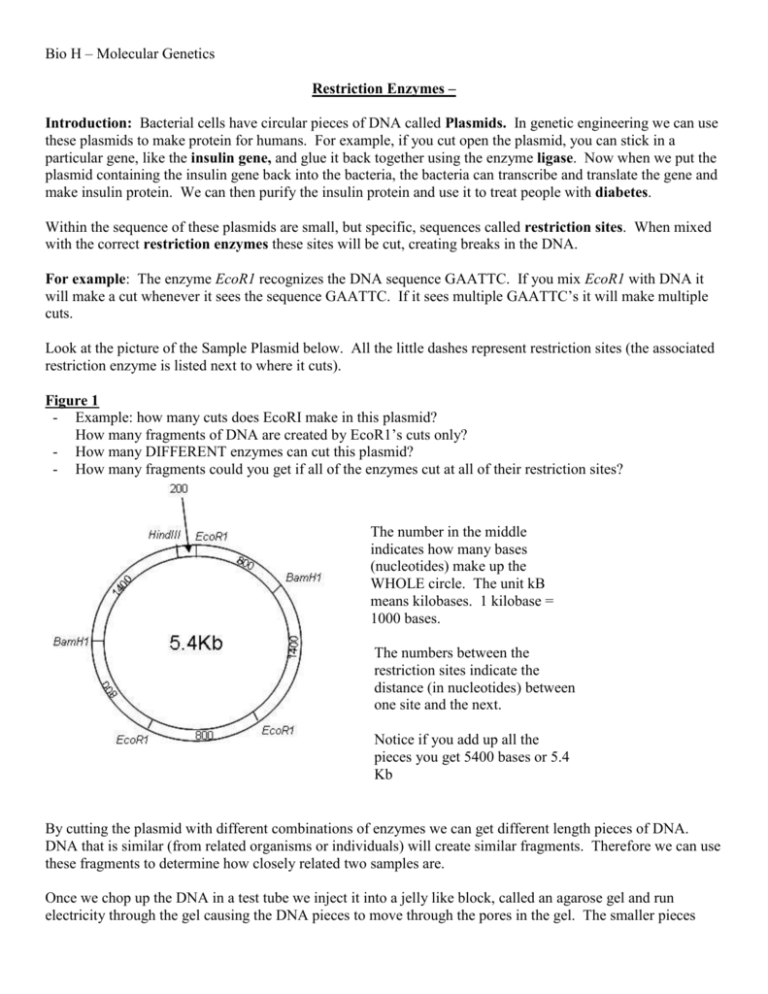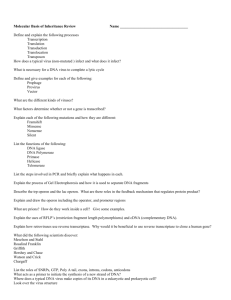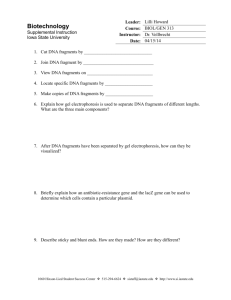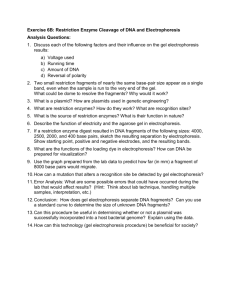Restriction Enzymes –
advertisement

Bio H – Molecular Genetics Restriction Enzymes – Introduction: Bacterial cells have circular pieces of DNA called Plasmids. In genetic engineering we can use these plasmids to make protein for humans. For example, if you cut open the plasmid, you can stick in a particular gene, like the insulin gene, and glue it back together using the enzyme ligase. Now when we put the plasmid containing the insulin gene back into the bacteria, the bacteria can transcribe and translate the gene and make insulin protein. We can then purify the insulin protein and use it to treat people with diabetes. Within the sequence of these plasmids are small, but specific, sequences called restriction sites. When mixed with the correct restriction enzymes these sites will be cut, creating breaks in the DNA. For example: The enzyme EcoR1 recognizes the DNA sequence GAATTC. If you mix EcoR1 with DNA it will make a cut whenever it sees the sequence GAATTC. If it sees multiple GAATTC’s it will make multiple cuts. Look at the picture of the Sample Plasmid below. All the little dashes represent restriction sites (the associated restriction enzyme is listed next to where it cuts). Figure 1 - Example: how many cuts does EcoRI make in this plasmid? How many fragments of DNA are created by EcoR1’s cuts only? - How many DIFFERENT enzymes can cut this plasmid? - How many fragments could you get if all of the enzymes cut at all of their restriction sites? The number in the middle indicates how many bases (nucleotides) make up the WHOLE circle. The unit kB means kilobases. 1 kilobase = 1000 bases. The numbers between the restriction sites indicate the distance (in nucleotides) between one site and the next. Notice if you add up all the pieces you get 5400 bases or 5.4 Kb By cutting the plasmid with different combinations of enzymes we can get different length pieces of DNA. DNA that is similar (from related organisms or individuals) will create similar fragments. Therefore we can use these fragments to determine how closely related two samples are. Once we chop up the DNA in a test tube we inject it into a jelly like block, called an agarose gel and run electricity through the gel causing the DNA pieces to move through the pores in the gel. The smaller pieces Bio H – Molecular Genetics will work their way through the maze-like pores faster than the long pieces. For this reason, we can separate out the DNA fragments based on size: long pieces on the top of the gel, small piece nearer to the bottom. This is called gel electrophoresis. See diagram below Figure 2 Make Gel Block with “wells” for the DNA Inject Marker – a mix of DNA fragments of KNOWN sizes Inject your DNA samples of unknown sizes Apply an electric current to the top of the gel (DNA is inherently negative and will be repelled by the negative side and attracted to the positive side) 5. Wait… it takes time for all the DNA fragments to move 6. Compare the Bands of DNA in your samples to the known fragments in the marker to determine their size. Remember small bands travel farther than long bands!!! 1. 2. 3. 4. Things to note about electrophoresis: 1. Each differently sized fragment will make a distinct band 2. If you have two bands the same length they will blend together and look like one. If you have MANY fragments the same length, they will still show up as one band on the gel, but may look thicker or darker. 3. The left most lane always is filled with a marker or “ladder” rather than a sample. The fragments in the ladder are of known length. We use this to compare the bands that come from our unknown samples. Bio H – Molecular Genetics Example: Let’s say we digest (cut) your sample plasmid (fig. 1) with EcoRI and BamHI. - you will end up with 4 pieces. o Piece one (from EcoRI BamHI) 800 base pairs (bp) o Piece two (from BamHI EcoRI) 1400 bp o Piece three (from EcoRI EcoRI) 800bp o Piece four (from EcoRI BamH1) 800 bp o Piece five (from BamH1 through HindIII to EcoRI) 1400+200 = 1600 Your Gel will look like this (L = Ladder; S = Sample) L S 3000 2000 1000 800 600 400 100 Notice there is 1-1600bp band, 1-1400bp band and only 1-800 band even though we had three 800bp fragments. However, if there were 100 800bp fragments, the 800bp band might look thicker and darker. Bio H – Molecular Genetics Plasmid Analysis Questions: Use your assigned plasmids (not fig. 1) to answer the questions below in complete sentences PLASMID ID #: ___________________(number in parentheses in upper right corner) 1. What is the total length of your plasmid in kB? In bp? 2. How many DIFFERENT enzymes cut your plasmid? Name them. 3. If you cut your plasmid with EcoRI and BamHI how many pieces will you end up with and what will their sizes be? 4. Use the ladder as a guide and draw in the fragments above as they would appear when you added your sample to the gel. Add in the exact lengths to the right of each band. L 3000 2000 1000 800 600 400 100 S Bio H – Molecular Genetics 5. Let’s say that your lab partner set up the plasmid and the enzymes and forgot to write down which enzymes he or she added. You check your sample on the gel and get the following band pattern. What enzymes were used? Explain. L S 3000 2000 1000 800 600 400 100 6. Now you are adding in your insulin gene which is 1.5 kB long. However, you do all of this in a test tube. So when you “seal” the gene in the plasmid, you need to test whether the gene got added into the plasmid or if the plasmid sealed up by itself. Explain how you can use restriction enzymes and electrophoresis to tell whether your gene got inserted. 7. In DNA fingerprinting, you can use restriction enzymes and electrophoresis to match blood samples or determine paternity (whether a child belongs to a particular parent). Explain how this process would be able to differentiate between people who are related and people who are not.








